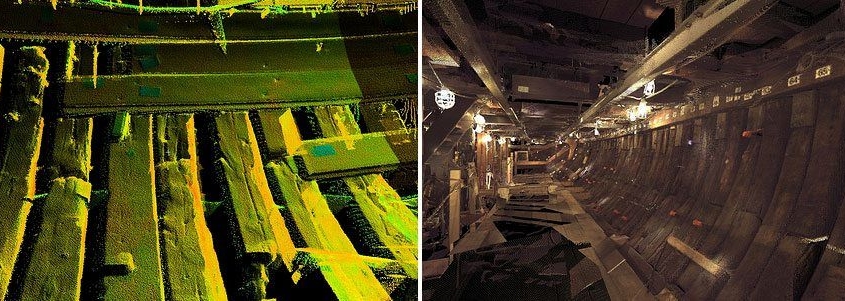Laser Scanning the Hold of the Charles W. Morgan
In an effort to precisely document the measurements of the Charles W. Morgan, Feldman Land Surveyors from Boston, MA used a Leica Geosystems ScanStation 2 3D laser scanner to create a photo-realistic 3-D model of the ships hold.
History
Charles W. Morgan was a U.S. whaleship during the 19th and early 20th century. Ships of this type usually harvested the blubber of whales for whale oil, which was commonly used in lamps during the time period. The ship is currently an exhibit at the Mystic Seaport museum in Mystic, Connecticut.
The ship is named for its original owner, a Quaker whaling merchant who ordered its construction from the shipbuilders Jethro and Zachariah Hillman of New Bedford, Massachusetts. The ship’s maiden voyage began on September 6, 1841, with a journey around Cape Horn and cruised across the Pacific Ocean. Following the Morgan’s initial three year and four month voyage, she came home with 1,600 barrels of sperm oil, 800 barrels of whale oil and 10,000 lbs of whalebone, known as baleen, which was worth around USD$56,000.
The hull and deck of Morgan reflected the industry which she was built to serve. A typical whaleship has three functions:
- to serve as a mother ship to a fleet of small whaleboats, which are stored on the davits when not in use,
- to serve as a factory and a refinery ship with tryworks for extracting oil from the whale blubber,
- to serve as oil tankers.
In her 80 years of service, she made 37 voyages ranging in length from nine months to five years. Charles W. Morgan, in total, brought home 54,483 barrels of sperm whale oil and 152,934 pounds of whalebone. She sailed in the Indian and South Atlantic Oceans, surviving ice and snow storms. Her crew survived a cannibal attack in the South Pacific. Between 1888 and 1904 she was based in San Francisco.
Morgan had more than 1,000 whalemen of all races and nationalities in her lifetime. Her crew included not only Americans, but sailors from Cape Verde, New Zealand, the Seychelles, Guadeloupe, and Norfolk Island. The ship’s crew averaged around 33 men per voyage. As with other whaleships in the 1800s, Morgan often was home to the captain’s family. The Morgan was owned and managed by the J. & W. R. Wing Company of New Bedford.[3]
During its years of service, Charles W. Morgan was used in several movies, including Miss Petticoats (1916), Java Head (1921) and Down to the Sea in Ships (1922).
On the night of June 30, 1924, the Charles W. Morgan caught fire when the flaming wreck of the steamer Sankaty, which had drifted across the Acushnet River from New Bedford harbor in flames, collided with it. Badly charred, Morgan narrowly escaped destruction.[4][5][6]
One of the Charles W. Morgan’s whaleboats, featuring models of crew members with oars and harpoons.
Retirement
The whaling days came to an end with the perfection of refining petroleum. Morgan was under the care of Whaling Enshrined, Inc. until 1941, when she was transferred to Mystic Seaport, where she still stands to this day. The ship is the only surviving wooden whaleship from the 1800s American fleet.[7]
Restoration
The 1971 U.S. commemorative stamp honoring the Charles W. Morgan
The Charles W. Morgan arrived at Mystic Seaport in December 1941, narrowly avoiding destruction during World War II. The ship was declared a National Historic Landmark and listed on the National Register of Historic Places in 1966.[2][7][8]
An initial restoration and preservation project was undertaken in 1968. A new restoration effort took place in 2009.
Mystic Seaport has recently completed a multi-million dollar shipyard upgrade to accommodate the next phase of Morgan’s restoration, which is currently underway.
In 1971, the United States Postal Service issued a commemorative stamp honoring the Charles W. Morgan.
Laser Scanning blends highly accurate measurements with three dimension expression of the space and the relationship among the various structural elements. It not only gives us a record of the vessel but has tremendous value as an educational tool describing the structure to those not familiar with traditional naval architectural drawings.




Leave a Reply
Want to join the discussion?Feel free to contribute!